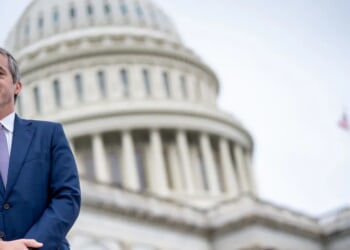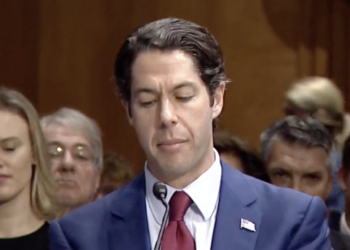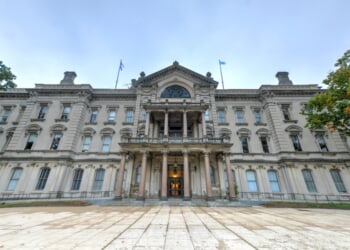
President Donald Trump announced Thursday he is raising tariffs on Canadian imports from 25% to 35%, citing Canada’s failure to cooperate in curbing the flow of fentanyl and other illicit drugs into the United States.
🚨 BREAKING: President Trump just signed an order RAISING his reciprocal tariff on Canada from 25% to 35%, effective at midnight
This comes after Canadian PM Carney tried playing games on trade
FAFO, Canada! pic.twitter.com/a0caM6EgxY
— Nick Sortor (@nicksortor) July 31, 2025
Trump’s Sovereign Wealth Fund: What Could It Mean For Your Money?
The increased tariff will take effect on Friday.
The move follows a series of executive actions signed by the President to address what the White House described as threats to U.S. national security and economic stability.
This Could Be the Most Important Video Gun Owners Watch All Year
Trump signed two executive orders on Thursday—one specifically targeting Canada with the increased tariff, and another modifying reciprocal tariff rates on a broader scale to address longstanding trade imbalances with several nations.
“These actions are designed to protect the United States from foreign threats to both our security and economy, and to ensure fair, balanced and reciprocal trade relationships,” the White House stated.
In addition to the 35% tariff on Canadian goods, President Trump announced on April 2 a 10% baseline tariff on all countries, with higher rates imposed on nations running large trade surpluses with the U.S. That measure took effect on April 9.
Subsequently, the U.S. secured a number of trade agreements. The European Union agreed to purchase $750 billion in American energy and pledged $600 billion in new investments by 2028.
The EU also accepted a 15% tariff rate.
Japan followed with a commitment to invest $550 billion into American industry and agreed to broaden its market to U.S. exports, also under a 15% tariff structure.
Other revised tariff rates include Syria at 41%, Myanmar and Laos at 40%, Switzerland at 39%, Serbia and Iraq at 35%, and Algeria, Bosnia and Herzegovina, Libya, and South Africa at 30%, according to a list released by the White House.
The administration defended its trade strategy as a necessary countermeasure against economic threats and as part of the broader “America First” approach.
“President Trump is using tariffs as a necessary and powerful tool to put America first after many years of unsubstantiated trade deficits that threaten our economy and national security,” the White House said.
Fentanyl trafficking, particularly from Canada and Mexico, has been central to the administration’s justification for aggressive tariff action.
Earlier this month, Trump warned that Canada would face a 35% tariff beginning August 1, accusing the Canadian government of neglecting its responsibility to combat fentanyl trafficking and retaliating against the U.S. with its own tariffs.
According to U.S. Customs and Border Protection, 74 pounds of fentanyl have been seized at the northern border in fiscal year 2025.
The administration has also pointed to intelligence suggesting that Mexican drug cartels are operating fentanyl and nitazene synthesis labs inside Canada.
Additionally, the Trump administration has accused Canadian drug trafficking networks of maintaining large-scale “super labs” capable of producing 44 to 66 pounds of fentanyl weekly, primarily in western Canada.
In a letter to Canadian Prime Minister Mark Carney earlier this month, President Trump reaffirmed the importance of the U.S.-Canada trade relationship but criticized Canada’s decision to impose retaliatory tariffs.
Trump wrote that beginning August 1, a 35% tariff would apply to Canadian products entering the U.S., and that attempts to evade these tariffs would be met with increased penalties.
Ontario Premier Doug Ford responded Thursday to Trump’s announcement by calling for a firm response from the Canadian government.
“We need to stand our ground,” Ford posted on X.
“The increase in U.S. tariffs to 35 per cent is concerning, especially with tariffs still in place on steel, aluminum, autos, forestry and now copper.”
He emphasized that while over 90% of Canadian exports are covered under USMCA with zero tariffs, the federal government must take action to shield Canadian workers and businesses.
“The federal government needs to hit back with a 50 per cent tariff on U.S. steel and aluminum,” Ford added.
“Canada has what the United States needs: oil and gas, critical minerals, steel and aluminum, electricity, potash and uranium.”
Ford concluded his remarks by calling for unity and certainty.
“Canadian workers and businesses are desperate for certainty,” he said.
“Let’s work together, united, to deliver it.”
Canada shouldn’t settle for anything less than the right deal. Now is not the time to roll over. We need to stand our ground.
The increase in U.S. tariffs to 35 per cent is concerning, especially with tariffs still in place on steel, aluminum, autos, forestry and now copper.…
— Doug Ford (@fordnation) July 31, 2025
Earlier this year, President Trump imposed 25% tariffs on Canadian steel, autos, and other goods not covered under USMCA. In response, Canada imposed $43 billion in retaliatory tariffs on U.S. goods.
Trump first announced the tariffs on his first day in office in January after formally declaring the fentanyl crisis a national emergency.
The latest escalation with Canada marks one of the administration’s strongest economic responses to the cross-border drug issue.

![Trump Slaps Canada with a Tariff Increase Over Failure to Curb Flow of Fentanyl [WATCH]](https://www.right2024.com/wp-content/uploads/2025/08/Trump-Slaps-Canada-with-a-Tariff-Increase-Over-Failure-to-750x375.jpg)
![Former Bravo Star Charged After Violent Assault Using a Rock-Filled Sock in Tennessee Walmart [WATCH]](https://www.right2024.com/wp-content/uploads/2025/07/Former-Bravo-Star-Charged-After-Violent-Assault-Using-a-Rock-Filled-350x250.jpg)




![Karoline Leavitt Levels CNN's Kaitlan Collins and Other Legacy Media Reporters [WATCH]](https://www.right2024.com/wp-content/uploads/2025/07/Karoline-Leavitt-Levels-CNNs-Kaitlan-Collins-and-Other-Legacy-Media-350x250.jpg)
![Man Arrested After Screaming at Senators During Big Beautiful Bill Debate [WATCH]](https://www.right2024.com/wp-content/uploads/2025/06/Man-Arrested-After-Screaming-at-Senators-During-Big-Beautiful-Bill-350x250.jpg)
![Illegal Alien Walked Free After Decapitating Woman, Abusing Corpse for Weeks [WATCH]](https://www.right2024.com/wp-content/uploads/2025/07/1753013138_Illegal-Alien-Walked-Free-After-Decapitating-Woman-Abusing-Corpse-for-350x250.jpg)







